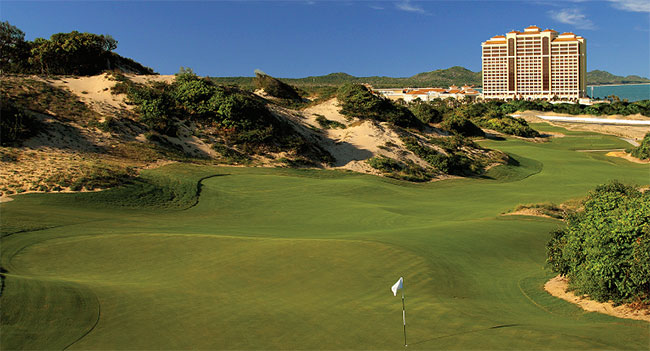 |
Having lived in Vietnam for the past 20 years, Colin Pine, general director of Ho Tram project company, has called Hanoi, Ho Chi Minh City and Ba Ria Vung Tau home.
"Over the years, I have found that different regions in Vietnam have their own unique culture. Many people perceive Thailand's tourism image to be a smile and Singapore's to be cleanliness, but what about Vietnam? I find Vietnamese people to be very friendly, which is why I enjoy living here, and feel that this friendliness as well as the cultural diversity across regions should form part of the country's image," Colin shares.
Believing in the huge potential of Vietnam's tourism industry, strong and committed investors including Harbinger Capital Partners and Pinnacle Entertainment Inc. have provided capital of over $100 million to the Ho Tram Strip project in the past 12 months.
"Our vision is to create a true world- class destination, one that will draw international visitors to the southern region of Vietnam, not only once, but multiple times, while at the same time creating a multi-experience vacation retreat for Vietnamese families", he adds.
In terms of branding Ho Tram Strip as an international standard, large-scale integrated resort, Colin highlights that its brand is built based on world-class accommodation, a golf course, casino, and other entertainment and recreation facilities as well as the emotional impacts it has on the customers, its truly unique services and experiences and clear positioning as a world-class tourism destination.
Regarding the branding of Vietnam's tourism, Colin believes that the Vietnam National Administration of Tourism (VNAT) is a flexible unit open to change.
"However, there are some issues relevant to tourism that VNAT has no control over, such as the government budget and how joint responsibility is shared between ministries," he adds.
Meanwhile, New Zealand Ambassador to Vietnam, Haike Manning, says Vietnam has huge tourism potential.
'You have beautiful landscapes such as Halong bay, plus culture, adventures and food. There are so many ingredients to build up the country's brand and profile. I think the key to get people come back is the quality of service so that people can feel very comfortable when they come here."
BRANDING CONTROVERSYAt a conference entitled Developing Vietnam's Tourism Branding Strategy to 2025, with Outlook to 2030, held on April 16, a number of issues relating to creating an image for Vietnam's tourism were raised.
Vietnam has changed its tourism logo and slogan several times.
2004 to 2005, its slogan was Welcome to Vietnam, accompanied by a logo of a girl wearing an ao dai.
From 2006 to 2011, the slogan was changed to Vietnam - the Hidden Charm. Since 2012 the slogan has been Vietnam - the Timeless Charm.
According to Le Tuan Anh, deputy director of VNATs tourism marketing department, though the slogan and logo have changed, the brand remains the same.
"Vietnam's major appeal is its culture, history, and natural resources. Vietnam is able to attract a wide range of tourists by offering a diverse range of tourism products such as cultural tourism, sea and island tourism, urban tourism, and eco- tourism," he argues.
Vietnam, therefore, should consider the market in segments and target them in different ways.
"For example, European tourists tend to be attracted to Vietnam's history. As a result, when we approach this customer group, we focus on interesting aspects of our history," he says.
Trinh Minh Tu of Hanoi Haseco travel agency raised another issue re lating to government support: "Our government wants to make tourism a leading industry, but it can be really hard to get their support. VNAT can give ideas but will government ministers agree and support those ideas? We can all sit here together and create a master plan, but if there is no voice from the higher governing bodies, our efforts will be in vain."
Asked about Vietnam's key tourism offerings VNATs deputy director general Ha Van Sieu suggested Vietnamese food.
"Author and professor Philip Kotler once claimed that Vietnam is the world's kitchen. Through food, tourists can experience our culture, our regional differences, and our lifestyle," he says.
"Food is a very broad term, so we need to conduct research to find out which types of food set Vietnam apart from Thailand and Indonesia, as those two countries also focus on their food culture to promote their tourism appeal. I think Vietnamese food is becoming more and more popular in the world, particularly with the opening of pho and banh mi restaurants in major cities."
POSSIBLE SOLUTIONS
In order to improve Vietnam's tourism image, Ha Van Sieu suggests one solution could be to create a unit specialising in promoting national tourism.
"We need a tourism promotion unit to work with VNAT. It's really hard for VNAT to act as both a managing and promoting body. We need government spending on the table," Sieu said.
"For example, if the government budget allocated to tourism promotion this year is $2 million, then how many tourists will we be able to attract and how much should we spend to ensure Vietnam's tourism industry yields profit? After answering those questions, we will see that investing in tourism promotion is necessary."
According to Le Tuan Anh, Vietnam must adhere to the values of the national strategy for tourism.
"Vietnam has a diverse culture, which differs between regions. Each part of the country has its own story to tell and its own specialties to offer tourists. Therefore, in order to promote national tourism we need to understand that our tourism brand cannot be separated from our history and culture.”
Averie Nguyen
VIR